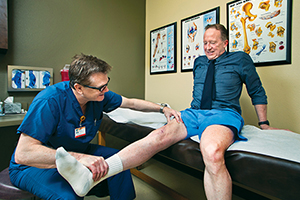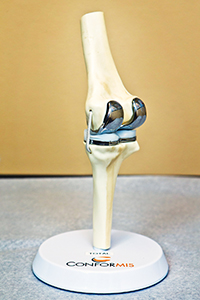By COLLEEN SCHRAPPEN
When Florence Valloni decided to have her knees replaced, she did her homework.
"I talked to hundreds of people," says Valloni, 67. "I was scared to death to do it."
She had been in pain about five years and had tried all kinds of solutions, from medicines to physical therapy.
Valloni, who lives in Las Vegas, even considered traveling to Pennsylvania to see the surgeon her brother used for the same procedure. That's about the time her Internet searches turned up the name of Dr. Robert Tait, an orthopedist and chief of staff at Dignity Health — St. Rose Dominican, Siena Campus, in Henderson, Nev.
Tait is an early adopter of an emerging orthopedic prosthetic technology for total knee replacement surgeries: the use of patient-specific implants manufactured in a 3-D printing process.

Image credit: L. E. Baskow /© CHA
Dr. Robert Tait, an early user of 3-D printed, custom knee joints, examines Dave Denham in June, four months after his knee joint replacement. The patient, an active 61-year-old, says his knee is pain free.
Custom fit
A surgeon for more than two decades, Tait, 57, had long been troubled by the national statistic that one in five patients are not happy with their knee replacement, mostly due to residual pain.
With more than 700,000 Americans undergoing the procedure each year, according to the American Medical Association, that's about 140,000 patients.
Tait says doctors don't fully understand the reasons for the residual pain. It may relate to implant position and implant size, but even when an implant fits perfectly and the alignment is correct, a patient may have lingering pain. The standardized three-dimensional shape of implants might be a factor, he said.
"That's really concerning for us," says Tait. "We've tried to improve designs, use different sizes, be gender-specific, use computer navigation — but it didn't really change the results for the patient."
Three years ago, Tait learned of a new technology that had the potential to improve outcomes. A manufacturer called ConforMIS, based in Massachusetts, was using 3-D printing technology to create custom knee joints and custom cutting blocks that are sized for the patient. The blocks allow the surgeon to cut away only damaged or diseased bone and minimize loss of healthy bone.
"Just intuitively, it made so much sense," says Tait.
Precision parts
The process starts with a CT scan of the patient's knee, hip and ankle. That result is converted into a three-dimensional model using proprietary design software. The femoral and tibial implants are then built in a 3-D printer to match the exact size and shape of a patient's knee.

Image credit: L. E. Baskow /© CHA
Dr. Robert Tait, an early user of 3-D printed, custom knee joints, examines Dave Denham in June, four months after his knee joint replacement. The patient, an active 61-year-old, says his knee is pain free.
Three-dimensional printers have been around since the 1980s but at the beginning were used mainly in the manufacturing and transportation industries. The medical field initially employed the technology for simple devices such as hearing aids and clamps.
In 2014, according to the medical journal Pharmacy and Therapeutics, medical uses accounted for less than 2 percent of all 3-D printing applications. That is expected to rise to 20 percent over the next decade.
The printer's "ink" is actually heated ballistic nylon printed layer by layer and capped with the standard metal used by most knee manufacturers, a cobalt-chrome-molybdenum alloy. The process, from determining a patient is a candidate for knee replacement to sending off the scan and getting back the custom knee, takes about six to eight weeks.
The initial price tag for a custom implant is higher than an off-the-shelf model, but Tait says that with no backlog of inventory and shorter hospital stays for recovery, the hospital's cost per procedure is less. And, he says, patients never pay more for the 3-D procedures than they would for a surgery with a traditional implant.
Going all-in
Tait performs about 200 knee replacements each year. He was so impressed with the 3-D model that by 2014, he was exclusively using the custom-made knees.
"I did a head-to-head study, and the results are so much better, I feel ethically obligated to do them," says Tait.
With off-the-shelf replacements, 6.8 percent of his patients had reported a "poor" post-surgery result. With the 3-D knee, that figure dropped to 2.4 percent, he says. And outcomes for all patients have improved across the board.
"Anecdotally, all our patients are showing their recovery is quicker and smoother," says Tait. "It's up to about 50 percent who don't have to do outpatient physical therapy at all, who can just do exercises at home." Previously, 90 percent did outpatient PT.
Basketball and bowling
Otis Mayberry, of Bullhead City, Ariz., did physical therapy for about two weeks after receiving a custom knee last June. "Then I really didn't feel a need for it," says Mayberry, 76.
He had had his other knee replaced about 16 years ago. "It took over two years to get that left knee how I wanted it," he says.
With the custom knee, he was out of the hospital in less time, his flexibility returned more quickly and he experienced less discomfort. "There was very, very little pain," he says.
He continued exercising on his own and was back bowling seven weeks after surgery.
Dave Denham of Las Vegas has a more physically demanding hobby: basketball. The former college player had been told in his 40s that he needed his knee replaced.
He put off the procedure as long as possible, compensating with foot orthotics and "taking anti-inflammatories like they were Cheerios," he jokes.
Finally, Denham, a certified orthotist, conceded. His hip and back were starting to give him problems as he shifted his gait to try to alleviate the pain in his knee.
"I called all my PT buddies in town and said, 'Who's getting the best outcomes?'" he says. "I'm a young 61 and still wanted to be able to ski and shoot basketballs. I've got to be able to squat down and help clients."
After meeting with Tait, Denham was convinced a ConforMIS knee would allow him to maintain the range of motion he required for his work and athletic pursuits.
His surgery was in early February. Five weeks later, he was shooting baskets with no pain. "My knee is the most stable it's felt in 30 years," he says.
Valloni, the patient who found Tait on the Internet, also had her first surgery in February. "I'm not going to go skydiving," she says. But the constant, aching pain she had experienced for the past five years is gone. She had her second successful knee replacement surgery with a 3-D joint in May.
Tait is hopeful that the success he has found with patient-specific knee implants will one day extend to other joint replacement surgeries, such as hip and shoulder replacements.
"Like any new technology, it takes a while to catch on," he says, "but the outcomes for patients receiving customized joints compared to off-the-shelf ones are like apples to oranges."